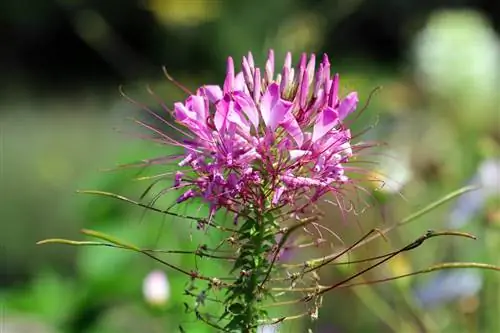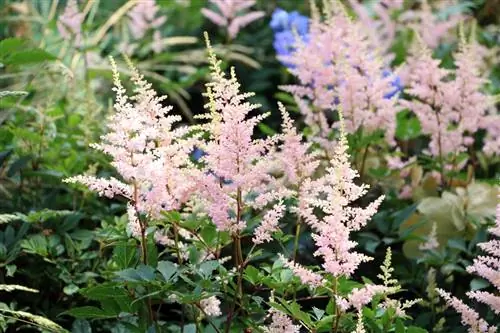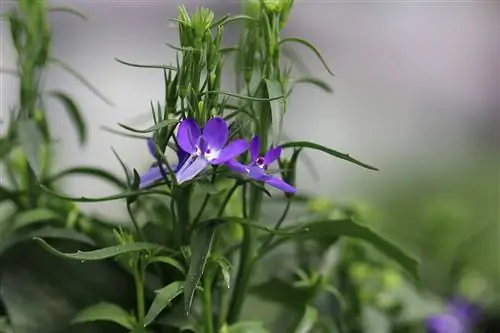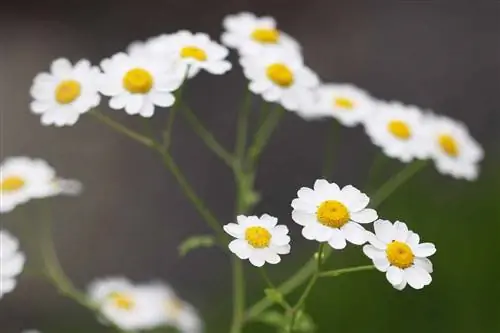- Author admin [email protected].
- Public 2023-12-17 03:39.
- Last modified 2025-01-24 12:45.
Feverfew, which looks very similar to chamomile, is valued not only as a medicinal herb but also as a decorative ornamental plant in a farm or natural garden. The easy-care plant requires a lot of sun and is an eye-catcher even in a natural meadow.
Profile
- Asteraceae family
- bot. Name: Tanacetum parthenium (syn. Chrysanthemum parthenium)
- also known as “false chamomile”, decorative chamomile or feverwort
- Avoid confusion with real chamomile
- should not be missing in any cottage garden
- Growth height 40 to 60 centimeters high
- white flowers with yellow flower basket
- Flowering period from June to September
- conditionally hardy
- Seeds itself again and again
Sowing
Once feverfew has been cultivated in the garden, it usually comes back again and again in the right location. The plant's sowing does not need to be controlled at all, as it reseeds itself every year thanks to the seeds it forms. Even if the mother plant has fallen victim to the winter cold. But cultivation through a first sowing is also possible:
- Get seeds from the store
- Place in growing pots with growing soil
- best time March
- Grow on windowsill until May
- Temperature around 15 ° Celsius is enough
- Germination time then two to three weeks
- then put the small plants in the garden bed in May
Tip:
To make a wild meadow even more colorful, you can sow the seeds directly here or in the garden bed in April and May without pre-seeding. Cover the seeds lightly with soil.
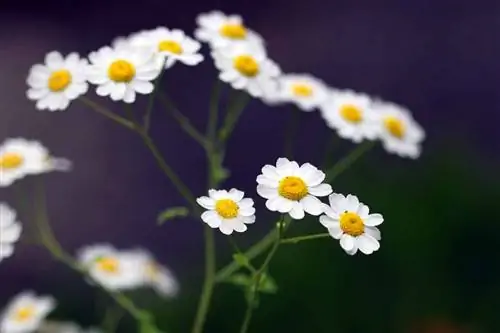
Flowering and flowering time
Chrysanthemum parthenium is a so-called permanent bloomer. Because once a flower has formed, it stays on the plant for a long time with the right care.:
- first flowers appear in June
- stay until September
- the flowers resemble those of chamomile
- small, white with a yellow center
- button flowers about three centimeters wide
- the flowers exude an aromatic scent
- Confusion can be avoided due to scent
- Flowers don't smell like chamomile
Note:
The herb gets its name from its previous use when it was used to induce labor in pregnant women. Confusion with chamomile could therefore be fatal in some cases. It was called feverweed because of its antipyretic properties.
Fertilizing and watering
The good news is that the herb tolerates lime well and can therefore also be used for watering:
- Always keep the substrate slightly moist
- only water directly to the roots
- a short drought is tolerated
- However, water young plants regularly
- on very hot days in the early morning hours
- alternatively water late in the evening
- no further fertilization in the first year if the soil is well prepared
- fertilize with compost in the spring of the second year
- alternatively or in the pot liquid fertilizer for flowers
Diseases and pests
Unfortunately, the young plants are very attractive to snails. It is therefore advisable to lay out a snail barrier right from the start when cultivating in a perennial garden bed. A snail fence or another natural barrier against the snails can be used for this purpose. If the plants are cultivated in pots, other pests must be taken into account:
- Aphids
- Spider mites
- like to attach themselves to the potted plants
- especially when there is a long drought
- take action against this with appropriate home remedies
- especially if the herb is used as a medicinal plant
- Fungal diseases occur when there is a lack of space
- So don't plant plants too close together
Container cultivation
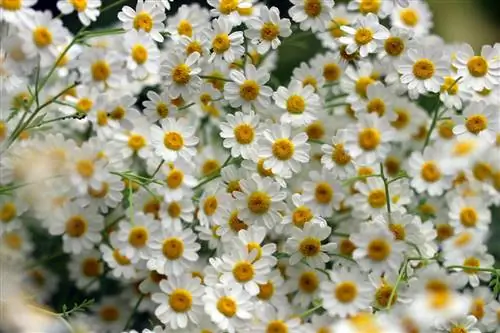
Feverfew (Tanacetum parthenium) can also be cultivated in a pot, for example together with a rose or alone. The following should be noted:
- spreading quickly
- put only one plant in a small pot
- create a drainage system to prevent waterlogging
- above drain hole
- Gravel, pottery shards or balls
- here plant fleece
- fill in half prepared soil
- Insert the plant and fill in the remaining soil
- press and pour well
Plants
Small plants in pots are available from well-stocked specialist retailers, which can then be planted out in the garden bed. The best time for this is spring, when the ground is no longer frozen:
- four plants are enough for one square meter
- here the feverfew is spreading
- after a short time covers the entire area
- Dig planting hole
- Insert the plant as deep as in the pot
- fill in prepared soil
- press well
- water well
Tip:
The ornamental plants also look particularly beautiful on a rose bed. Here they can cover the soil between the tall rose plants.
Cutting
The plants should always be cut if self-seeding is to be prevented. Because the plant can quickly multiply throughout the entire garden:
- always cut spent flowers immediately
- before seeds can be formed
- usually the first time in July/August
- also stimulates flower formation
- cut back to the base in spring
- how to stimulate new growth
- wooding can be delayed
Tip:
For additional plants, you should always leave individual seed heads. So they sow themselves and grow again in the same place the next spring.
Location and soil conditions
Finding the right location for feverfew is actually easy. However, a few things should be taken into account when it comes to the nature of the soil:
- full sunny
- can spread a carpet of flowers here
- sunny bed
- on a blooming natural meadow
- Soil can be calcareous
- always keep slightly moist around plants
- Garden soil with compost underneath is sufficient

Wintering
Contrary to many assumptions, Tanacetum parthenium is a plant that is perennial when the winter climate allows it. On the other hand, it also sows itself again and again; the seeds that have fallen in the fall can survive on the hardy soil:
- hardy down to -12° Celsius
- protect in harsh regions
- Twigs over the roots help against frost
- lay out in late autumn
- cultivated in the pot a little more protection
- Cover the pot with brushwood mats
- place on wood or Styrofoam
- Put brushwood on the roots
- place in a protected corner
Propagate
In addition to the simple self-sowing process, through which feverfew actually becomes a plant that can survive on the same bed for many years, the plants can also be propagated via cuttings. This propagation is usually well suited for pot cultivation but also if another bed is to be planted with feverfew:
- choose young, herbaceous shoots
- about 15 to 20 centimeters long
- Do not squeeze interface
- use a sharp and clean knife
- remove lower leaves
- Place the lowest buds in a container with water
- place in a bright and warm location
- first roots appear, plant
- ideally in pots
- Are plants strong enough to put in the bed in spring



